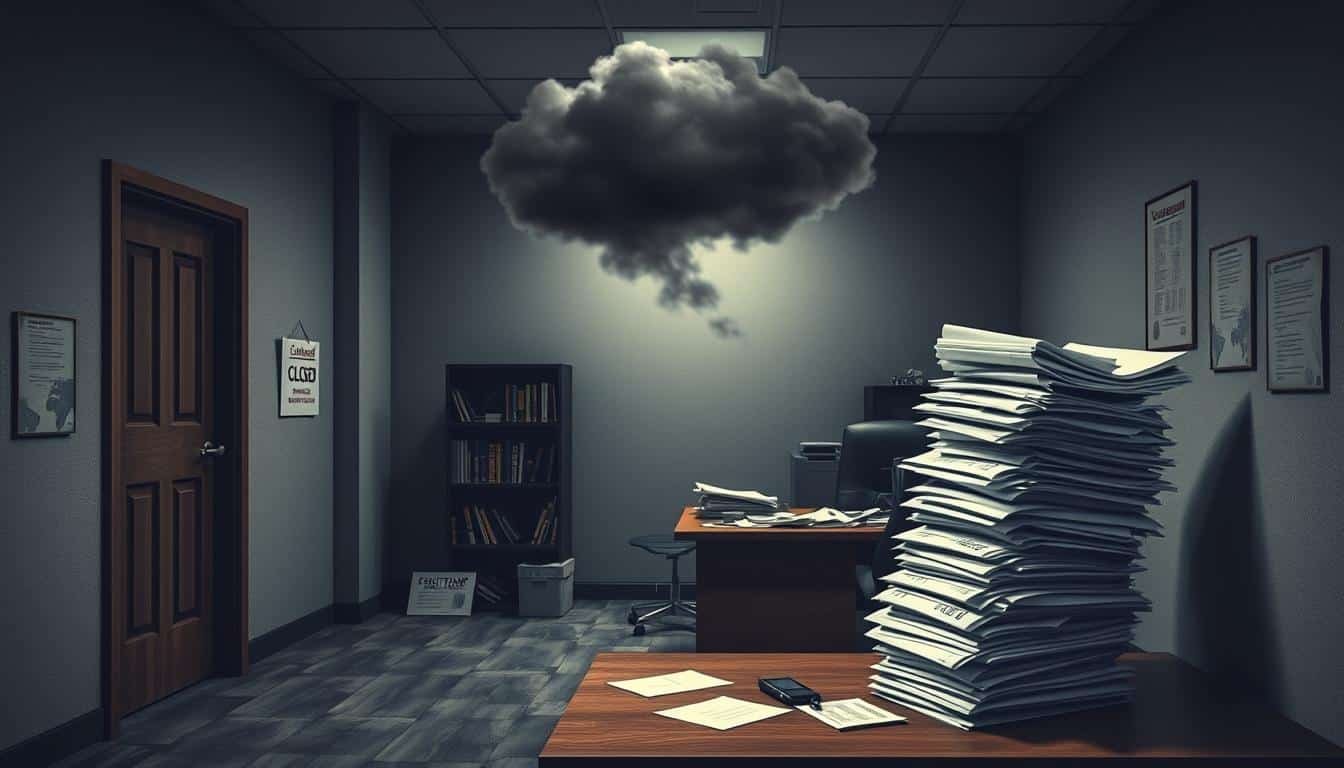Business What Happens When You Put a Lien on a Business-2025
Putting a lien on a business can lead to big legal and financial problems. It can be for unpaid debts, taxes, or other claims. Knowing what a business lien means is key for anyone dealing with business debts or trying to collect money.
So, what happens when you put a lien on a business? Let’s explore the world of business liens and the legal rules that apply.
Key Takeaways
- Liens can be placed on businesses for unpaid debts, taxes, or other legal claims.
- The process of placing a lien involves specific legal procedures and can have far-reaching consequences for the business.
- Liens can impact a business’s financial stability, credit rating, and ability to operate effectively.
- Resolving a lien often requires negotiating with the creditor or seeking legal assistance.
- Secured creditors have certain rights, including the ability to seize assets, that must be understood.
Understanding Business Liens
When a creditor wants to secure debt, they might put a lien on a business’s assets. These liens come in different forms, each with its own legal basis and effects. It’s key for business owners to know the types of liens against businesses and the legal grounds for placing a lien.
Types of Liens Against Businesses
- Tax Liens: Governments can place liens on a business’s property to collect unpaid taxes.
- Mechanic’s Liens: Contractors or suppliers can file a lien if a business fails to pay for work or materials provided.
- Judgment Liens: A court can order a lien to be placed on a business’s assets as a result of an unpaid judgment or legal settlement.
- Security Interests: Lenders can establish a lien on a business’s assets, such as equipment or inventory, as collateral for a loan.
Legal Grounds for Placing a Lien
- Unpaid Debts: Creditors can place a lien on a business’s property if the business fails to pay an outstanding debt.
- Unpaid Taxes: Governments can file tax liens against a business that has not paid its taxes.
- Breach of Contract: If a business breaches a contract, the other party may be able to place a lien on the business’s assets as a remedy.
- Court Judgments: A court can order a lien to be placed on a business’s property as a result of a legal judgment against the business.
Knowing the types of liens against businesses and the legal grounds for placing a lien is vital. It helps business owners manage their finances well and protect their assets.
| Lien Type | Description | Legal Grounds |
|---|---|---|
| Tax Lien | Government-imposed lien to collect unpaid taxes | Failure to pay taxes |
| Mechanic’s Lien | Contractor or supplier’s lien for unpaid work or materials | Failure to pay for work or materials provided |
| Judgment Lien | Court-ordered lien resulting from an unpaid legal judgment | Failure to pay a court-ordered judgment |
| Security Interest Lien | Lender’s lien on business assets used as collateral for a loan | Default on a loan agreement |
The Process of Placing a Lien on a Business
Understanding how to place a lien on a business can seem tough. But knowing the main steps can lead to success. The process of placing a lien on a business, the debt recovery process, and asset attachment procedures are key when trying to get unpaid debts back.
The first thing to do is show you have a legal reason for the lien. This means proving the business didn’t pay a debt or meet a contract. After proving this, you need to file the right papers with places like the county recorder’s office or the Secretary of State.
- Determine legal grounds for placing a lien
- File the necessary paperwork with the authorities
- Serve the business with a notice of the lien
- Monitor the lien’s status and enforce it if necessary
Once the lien is filed, you must tell the business about it. This warning lets them know about the lien and what could happen if they don’t pay. You also need to keep an eye on the lien and be ready to take action if the business doesn’t pay.
The process of placing a lien on a business is a strong way to get debts back. By knowing the law and following the right steps, you can better protect your money and interests.
Impact of a Lien on Business Operations
When a lien is placed on a business, it can deeply affect its daily operations. The financial implications and reputational consequences of a lien can pose big challenges for the company.
Financial Implications
A lien can make it hard for a business to get credit or financing. Lenders might be wary of lending to a company with a lien, seeing it as riskier. This can limit the business’s ability to grow, buy what it needs, or even cover basic costs.
The impact of a lien on business operations can threaten the company’s financial health and future.
Reputational Consequences
A lien can also harm a business’s reputation. It might be seen as a sign of financial trouble or poor management. This can lead to a loss of trust and credibility.
It can be tough to attract new customers, get good deals, or keep strong relationships with partners. The reputational consequences of a lien can hurt the business’s brand and image for a long time.
| Impact of a Lien | Financial Implications | Reputational Consequences |
|---|---|---|
| Restricted access to credit and financing | Limited ability to invest in growth or cover expenses | Loss of trust and credibility with customers, suppliers, and partners |
| Jeopardized financial stability and long-term viability | Increased risk for lenders and investors | Damage to the business’s brand and image |
Resolving a Lien Against a Business
When a lien is placed on a business, it’s crucial to act quickly. First, understand the lien’s nature and why it was filed. This info helps in negotiating a fair settlement with the creditor.
Negotiating a Settlement
Negotiating a settlement is a smart way to tackle a business lien. The aim is to find a deal that pays off the debt without hurting the business too much. This might include:
- Proposing a payment plan that fits the business’s financial capabilities
- Requesting a reduction in the outstanding amount or interest rates
- Offering collateral or assets as part of the settlement agreement
- Seeking legal counsel to ensure the settlement terms are fair and enforceable
By working together with the creditor, businesses can often find a way to resolve the issue. This lets them focus on growing while paying off debts.
Unpaid Debt Resolution Strategies
Businesses can also try other ways to deal with unpaid debt and remove the lien. These strategies include:
- Refinancing the debt with a new lender at more favorable terms
- Seeking mediation or arbitration to resolve the dispute outside of court
- Pursuing legal action to challenge the validity of the lien or debt
- Liquidating assets or securing additional funding to pay off the outstanding debt
Exploring different options can help businesses find a solution that keeps their operations running smoothly and financially stable.
What Happens When You Put a Lien on a Business
Putting a lien on a business can lead to big legal and financial problems. It’s like saying you have a claim on the business’s stuff. This can really limit how well the business can run.
One big issue is that the business can’t use its assets as collateral anymore. This makes it hard for the business to get loans or do other financial deals. It can stop the business from getting the money it needs to grow or even pay its bills.
| Potential Consequences of a Business Lien | Impact |
|---|---|
| Financial Restrictions | Inability to use encumbered assets as collateral, limited access to capital |
| Reputational Damage | Perceived financial instability, loss of trust from customers and partners |
| Operational Disruptions | Seizure of assets, legal proceedings, potential business closure |
A lien can also hurt the business’s reputation. People might think the business is not stable or has legal issues. This can make it hard to get new customers, loans, or keep current relationships.
Getting rid of a lien can be hard and take a lot of time. It might need talks with the creditor and could involve going to court. Businesses with a lien should get help from lawyers and financial experts to deal with it and lessen its effects.
Secured Creditor Rights
When a business owner can’t pay their debts, secured creditors have rights to get their money back. These rights protect lenders who lent money using collateral like property or equipment.
Property Seizure Laws
Secured creditors can take the assets used as collateral. They can sell these assets to pay off the debt. But, they must follow strict legal steps to do this.
Asset Attachment Procedures
Secured creditors can also attach assets to recover their money. This means they get a court order to put a lien on the assets. Then, they can sell the assets at auction to pay the debt.
| Secured Creditor Rights | Description |
|---|---|
| Property Seizure | Creditors can take possession of collateral assets and liquidate them to recover unpaid debts. |
| Asset Attachment | Creditors can obtain court orders to place liens on the debtor’s assets, restricting their ability to sell or transfer ownership. |
Knowing about secured creditor rights helps businesses deal with debt problems. Talking and negotiating with creditors can lead to good solutions for everyone.
Asset Attachment Procedures
When a business can’t pay its debts, creditors might seize its assets. This is a legal way to get back what’s owed. Knowing how this works can help businesses make smart choices.
The first step is when a creditor files a legal notice. This tells the debtor they plan to take certain assets. The notice explains the debt, the assets, and when they might be taken. The debtor can try to settle the debt before this happens.
- Documentation requirements: Creditors need to show proof of the debt and details of the assets. They also need court orders.
- Notice and hearing: The debtor gets notice and a chance to speak before assets are taken.
- Court involvement: Often, a court must approve the process to make sure it’s fair.
Asset attachment can hurt a business a lot. It can affect its operations, finances, and reputation. By understanding this, businesses can prepare better. This helps with commercial debt collection and unpaid debt resolution.
Commercial Debt Collection Methods
Businesses face many challenges when dealing with unpaid debts. Creditors use different methods to get what’s owed to them. These can include negotiating payments or using legal actions like lien enforcement.
Lien enforcement tactics involve placing a claim on the debtor’s assets. This can be property or equipment. It’s a strong way to get paid, but it might hurt the debtor’s business and reputation.
Creditors also use other commercial debt collection methods to solve unpaid debt issues. They might send demand letters, work with collection agencies, or go to court. The right method depends on the situation and if both sides can agree.
The aim of unpaid debt resolution is to balance what the creditor needs with what the debtor can afford. Finding a settlement or payment plan can help. It avoids long legal fights and keeps business relationships strong.
Knowing about different debt collection methods helps businesses deal with unpaid debts better. It protects their money while keeping things fair for everyone involved.
Unpaid Debt Resolution Strategies
When businesses face unpaid debts and liens, they have several strategies to tackle these problems. Negotiation is a key first step. Here, businesses work with creditors to change payment terms or set up payment plans. Sometimes, they might even get debt forgiveness.
Lien Enforcement Tactics
Businesses with liens need to act quickly to lessen the impact. They can use legal help to understand lien laws and challenge the lien’s validity. They might also try to settle the lien to get it released.
By using these strategies, businesses can deal with lien enforcement. This helps them find a good solution and keep their operations running smoothly.
Open communication, financial planning, and knowing about commercial debt collection are key. These help businesses handle unpaid debts and liens. This way, they protect their assets and keep their business going.
FAQ
What is a business lien and how does it work?
A business lien is a legal claim on a company’s assets by a creditor or the government. It’s used to ensure payment of an outstanding debt. Once a lien is placed, the creditor can seize and sell the business’s property to cover the debt.
What are the different types of liens that can be placed on a business?
There are several types of liens on businesses. Tax liens are for unpaid taxes. Mechanic’s liens are for contractors who haven’t been paid. Judgment liens come from court rulings in favor of creditors.
What are the legal grounds for placing a lien on a business?
Creditors can place a lien on a business’s assets if the company hasn’t paid a debt. This includes loans, invoices, or taxes. The process usually involves a court judgment or following specific laws, depending on the lien type.
How does the process of placing a lien on a business work?
The process starts with the creditor filing paperwork with the government. This could be the county recorder’s office or the Secretary of State. Once filed, the lien is officially on the business’s property, ready to be seized and sold.
How does a lien impact a business’s operations and finances?
A lien can severely affect a business. It can harm the company’s credit and make getting financing hard. It also disrupts operations and can damage relationships with customers and suppliers.
What are the steps a business can take to resolve a lien?
Businesses can resolve a lien by negotiating with the creditor or setting up a payment plan. They can also seek legal help to challenge the lien. The goal is to pay off the debt and remove the lien.
What are the rights and protections afforded to secured creditors with a lien?
Secured creditors have rights and protections with a lien. They can seize and sell the property to recover the debt. This is based on state laws and is known as the creditor’s “right of attachment.”
How do asset attachment procedures work in the context of a business lien?
With a lien, the creditor can seize and sell the business’s property. This involves getting a court order and following steps to inventory and sell the assets. The goal is to satisfy the outstanding debt.
What debt collection methods can creditors use when a business has an unpaid lien?
Creditors have many ways to collect debts, including phone calls and legal action. For a business lien, they might seize assets or garnish bank accounts. These are aggressive measures to get the debt paid.
What are some effective strategies for businesses to resolve unpaid debts and liens?
Businesses can resolve debts and liens by negotiating or setting up a payment plan. Seeking legal help to challenge the lien is also an option. Being proactive and willing to find a solution is key.
Sajjad Hossain is an experienced writer on StatusCaption.xyz, specializing in insurance, business ideas, money management, and investment. With a passion for simplifying complex financial topics, [Author Name] provides clear and actionable insights to help readers make informed decisions in their financial journey. Committed to delivering expert advice and practical tips, Sajjad Hossain aims to empower readers to achieve their financial goals confidently and strategically.




